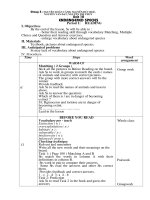Unit 10- Reading
Bạn đang xem bản rút gọn của tài liệu. Xem và tải ngay bản đầy đủ của tài liệu tại đây (120.58 KB, 4 trang )
Date of planning: Nov 24
th ,
2008 Unit 10 : NATURE IN DANGER Period: No 61
Date of teaching: Dec 27
th
, 2008 Lesson A: Reading
* Aim s of the lesson : By the end of the lesson, Ss will be able to:
- know the facts about endangered species.
- know how to protect the environment.
* Teaching aids : Textbook, lesson plan , pictures, posters.
* Procedures :
Time Contents Teacher’s activities Ss’ activities
5’
9’
8’
I. Warmer: Picture description
+ What animals can you see in the pictures?
+ Where do they live?
+ What would happen if their habitats were
destroyed?
+ What happens at the pictures at page 115?
* Answers:
+ We can see two cheetahs, a panda and a tiger
+ They often live in the forest, zoos or National
parks.
+ They would die and nature would be in danger.
+ The first picture: a forest fire
The second picture: an earthquake
The third picture : a flood.
II. Pre- reading
1. Vocabulary:
- exist (v): tån t¹i
- influence (n): sù ¶nh hëng
- destroy (v): ph¸ hñy
- respect (n): mèi quan hÖ
- consequence (n): hËu qu¶, kÕt qu¶
- extinct (adj):tuyÖt chñng
- prohibit (v): cÊm, kh«ng cho phÐp
- interference (n): sù can thiÖp
- survive (v): sèng sãt, tån t¹i
- offspring (n): con c¸i, dßng dâi
2. Setting the scene
* Answers:
1. The facts above show that the numbers of some
wild/ rare animals such as cheetahs, pandas and
tigers become small/ extinct.
2. The number of these animals have become small
because they are killed for food, fur or skin.
III. While – reading :
1. Task 1 : Filling the blanks
* Suggested answers :
1. exticnt 4. pollutants
2. protect 5. endangeredA
3. decreasing 6. interference
- ask Ss to look at the
pictures in the book and
answer some questions:
- Follow the steps for
teaching Voc.
- write these words on
the board:
- guide Ss to remember
- ask Ss to read the facts
about dangered species
and discuss the
questions.
- go around the class to
check and offer help.
- call on some Ss to give
their ideas and others
give comments.
-give feedback.
- ask Ss to read through
the words in the box and
read the sentences
carefully, then choose
the best words to fill in
the blanks.
- look at the pictures
in the book and
answer some
questions
- repeat the new
words
- listen to the
teacher and take
notes
- read the new
words in chorus.
- read the new
words individually.
remember the
words.
- read the facts
about dangered
species and discuss
the questions.
- read through the
words in the box
and read the
sentences carefully,
then choose the best
words to fill in the
8’
7’
2. Task 2 : Multiple choice ( individual work)
* Suggested answers :
1 - C 2 - B 3 - A 4 - C
3. Task 3 : Questions and answers
* Suggested answers :
1. Four ways that people change the world are:
+ changing the environment by building cities and
villages.
+ affecting the water supply by using water for
industry and agriculture.
+ changing weather conditions by cutting down
trees in the forests.
+ destroying the air by adding pollutants like smoke
from factories and fumes from cars.
2. The serious consequences of people’s
interference with the environment are:
+ many kinds of rare animals are killed.
+ the environment where these animals are living is
badly destroyed.
+ the numbers of rare animals are decreasing so
rapidly that they are in danger of becoming extinct.
3. Many things have been done to protect
endangered nature, such as:
+ many organizations have been set up and money
has been aised to save rare animals.
+ thousands of national parks have been
established.
+ laws have been passed to prohibit killing
endangered animals.
- ask Ss to work
individually to do the
task.
- go around to help Ss
when necessary.
- have Ss compare their
answer with a partner
for peer correction.
- call some Ss to read
their answers aloud in
front of the class.
- give the correct
feedback.
- ask Ss to read the
choices of each
paragraph to understand
them.
- ask Ss to read the text
again and do the task.
- have Ss to exchange
the answers with a
partner for peer
corection.
- call on some Ss to give
the answers.
- give correct answers.
- ask Ss to read the text
again more carefully and
try to find the
information to answer
the questions.
- ask Ss to work in pairs.
- call some Ss to read
the answers and give
explanation for their
answers.
- feedback and give
correct answers
- ask Ss to work in
blanks.
- read the choices of
each paragraph to
understand them
- read the text again
and do the task.
- read the text again
more carefully and
try to find the
information to
answer the
questions.
7’
1’
IV. Post – reading :
* Suggested answers :
- People kill animals for fur, skin and food.
- People keep animals as pets.
- People hunt or capture animals for
recreation or entertainment.
V. Wrapping up
groups and find out why
some animals have
become extinct.
- go around the class to
check and offer help.
- call on some groups to
present their ideas.
- give comments and
answer.
*Comments:summarise
the main points of the
lesson.
* Homework:
- leanr the new
words by heart.
- re- read the text .
- work in groups
and find out why
some animals have
become extinct.
- listen to T
- learn and do at
home
V I / Lesson Evaluation:
......................................................................................................................................................
.....................................................................................................................................................
==========*&*==========









